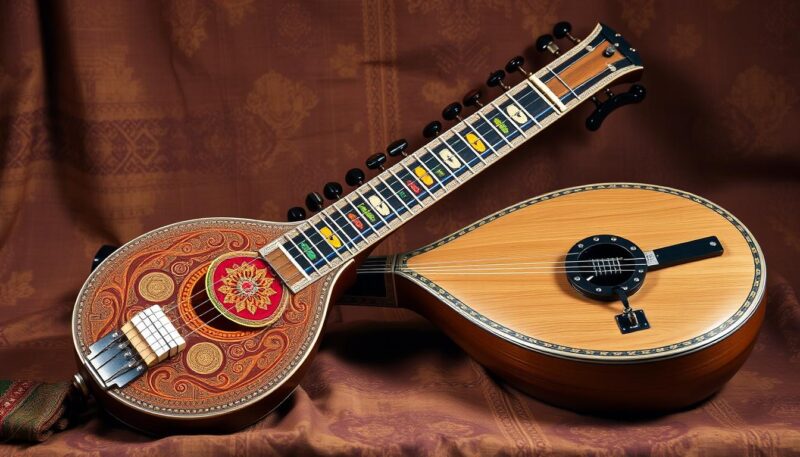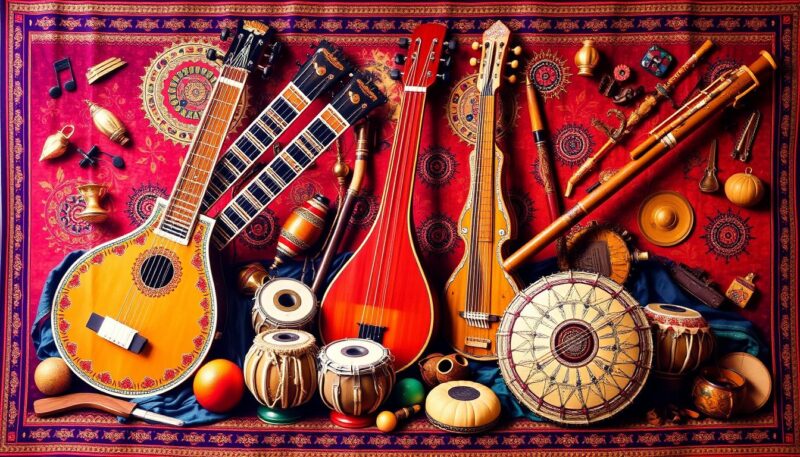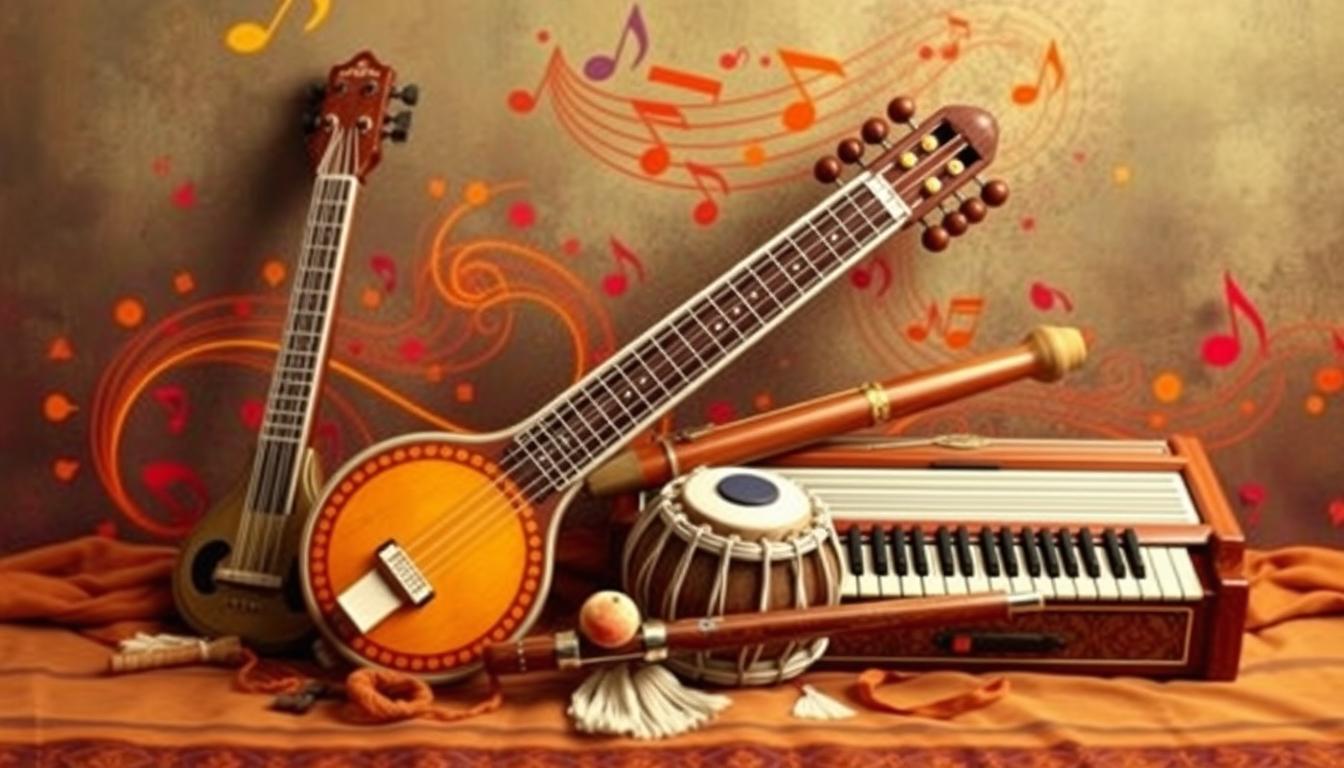Indian classical music, with its unique and enchanting sounds, has a rich tradition that dates back thousands of years. Though it evolves constantly, its deep roots in spirituality and tradition remain unchanged. Crafted with intricately designed ragas and talas, this musical form not only captures the essence of melody but also the profound spiritual depth.
Divided into Hindustani and Carnatic styles, Indian classical music has seen a journey stretching from the 12th century to the modern-day, harmonizing various cultural influences. Instruments like the sitar, tabla, and veena are more than just musical devices; they are icons, each note of which narrates the tales of India’s storied history.
Join us as we delve into the world of Indian classical instruments, exploring their history, varieties, and the cultural heritage they carry. This is a journey that promises to enrich your understanding of the spiritual depth of Indian music and underscore the cultural heritage of Indian instruments.
Key Takeaways
- Indian classical music has a rich tradition dating back thousands of years.
- The sitar and tabla are iconic instruments essential to Indian classical music.
- Indian classical music is intrinsically linked with spirituality and cultural heritage.
- Both Hindustani and Carnatic music styles form the two pillars of Indian classical music.
- Indian classical instruments carry history and tradition within each note.
Introduction to Indian Classical Music
Understanding Indian classical music opens a gateway to one of the most profound elements of India’s cultural expression. This musical tradition encompasses two major forms: Hindustani and Carnatic. Both forms share the foundational elements of ragas and talas, yet they exhibit distinct characteristics that set them apart.
The unique soundscapes of Indian classical music instruments resonate with the spiritual and cultural ethos of India. Hindustani music, which evolved during the Mughal rule, emphasizes improvisation and the in-depth exploration of a raga. In contrast, Carnatic music performances are usually short composition-based, celebrating the sophisticated intricacies of vocal prowess. Each form encompasses a rich repertoire drawn from the Samaveda, Natya Shastra, and other ancient texts that elaborate the structure, technique, and reasoning behind the music.
Indian classical music instruments are broadly categorized into four groups based on acoustic principles: stringed, wind, solid, and percussion instruments. This classification, rooted in the ancient Natyashastra, reflects the diversity and complexity of the tools used to create the distinctive sounds of Indian classical music.
Furthermore, the classical music genres of India, be it Hindustani or Carnatic, adhere to the profound understanding of ragas and talas encapsulated in seminal texts like the Sangitaratnakara. These texts are not only historic but continue to guide the musical journey of artists today, ensuring the perpetuation of one of the world’s oldest musical traditions.
History and Evolution of Indian Classical Instruments
The history of Indian musical instruments is as profound as the culture from which they emerge. With roots tracing back to Vedic times around 6,000 years ago, these instruments have continuously evolved, reflecting the dynamic nature of Indian music. The Natyashastra by Bharat Muni classifies these instruments into four main categories: Tat or Tantu Vadya (string), Sushir Vadya (wind), Awanadh Vadya (percussion), and Ghana Vadya (bells, cymbals, and gongs).
During the Mughal period, the Persian influence on Indian music significantly shaped the evolution of Indian classical instruments. Innovators like Hazrat Amir Khusro, who adorned the courts of seven Sultans of Delhi, are credited with the creation of the sitar, a cornerstone of Hindustani classical music. Similarly, the Sarod and Rebab, originating from Afghanistan, and the Shehnai, developed during the Mughal era, have been integrated into Indian music with remarkable success.
Instruments like the Mridangam, regarded as the oldest and most developed in South India, have been pivotal in Carnatic music. The Veena, frequently depicted in Indian iconography, has embodied the spirit of Indian music through countless generations.
“Music is the divine way to tell beautiful, poetic things to the heart.” – Pablo Casals
The evolution of Indian classical instruments also reflects the regional distinctions between North and South Indian music traditions. The Mridangam, primarily used in Carnatic music, highlights the uniqueness of South Indian music, whereas the tabla and sitar are more prevalent in Hindustani classical music. This diversity is a testament to the richness and depth of the history of Indian musical instruments.
| Period | Instrument | Significance |
|---|---|---|
| Vedic Times | Veena | Rooted in ancient traditions |
| Mughal Era | Sitar | Influence of Amir Khusro |
| Medieval Times | Mridangam | Key in South Indian Carnatic music |
| Modern Era | Tabla | Integral to Hindustani classical music |
From the court of Emperor Akbar to the modern world stage, the journey of Indian classical instruments reveals a narrative rich in cultural interactions and innovations. In recent history, musicians like Ravi Shankar and Ali Akbar Khan have popularized these instruments globally, further underscoring their enduring appeal and the ongoing evolution of Indian classical instruments.
Types of Indian Classical Instruments
Indian classical instruments are diverse and categorized based on their sound production methods. Each category, steeped in centuries-old tradition, continues to enchant audiences with distinct tones and playing techniques. Understanding these categories deepens your appreciation of the artistic and cultural richness of Indian music.
Tantu Vadya – String Instruments
Tantu Vadya, or string instruments, are among the most prominent in Indian classical music. This category is divided into three subcategories: Tat Vadya, Vitat Vadya, and Santoor. Instruments like the Sitar and Veena involve playing techniques of classical instruments where strings are plucked or strummed to produce mesmerizing melodies. The Sarod, believed to have evolved from the ancient Chitravina, is known for its deep, resonant sound, while the Sarangi, often described as ‘a hundred colors,’ offers an extensive range of expressive sounds. The Tanpura provides a foundational drone, crucial for maintaining pitch and harmony. The Violin, adopted into Indian classical music in the last century, exemplifies the dynamic adaptability of this tradition.
Sushir Vadya – Wind Instruments
Sushir Vadya, or wind instruments, produce sound through air flow. The Bansuri (flute) and Shehnai are classical examples. The Flute’s simple yet profound sound is achieved through expert breath control, while the Shehnai’s reed-based design adds a rich, complex texture to Indian compositions. Both instruments are integral to various classical performances, enhancing the emotional depth with their playing techniques.
Avanaddha Vadya – Percussion Instruments
Avanaddha Vadya, or percussion instruments, are essential for rhythm and tempo. This category includes the Tabla, celebrated for its versatility and widespread use in Indian music. The Pakhawaj accompanies the Dhrupad style of Hindustani classical music. Percussion instruments are classified based on playing techniques, such as those played with fingers like the Khanjira, with sticks like the Dhol, with palms like the Pakhawaj, and combined techniques like the Tabla. Each instrument contributes to the dynamic and rhythmic complexity that characterizes Indian classical performances.
Ghana Vadya – Solid Instruments
Ghana Vadya, or solid instruments, create sound through striking or shaking. Instruments such as the Manjira (clash cymbals) and Ghungroo (metallic bells) are integral to traditional setups. The JalTarang, with its melodic water-filled bowls struck with sticks, and the KaashthaTarang, played with a hammer, are prime examples of the innovative methods within this category. These instruments add unique rhythmic and melodic layers, making each performance a rich auditory experience.
Iconic Instruments in Indian Classical Music
The sitar, tabla, and veena are among the most iconic instruments in Indian classical music, embodying the rich cultural significance of Indian instruments. These musical instruments not only define the soundscape of Indian music but also reflect India’s rich heritage and tradition.
The Sitar
The sitar is a stringed instrument that holds a high cultural significance in Indian instruments. Introduced to India in the 13th century, it is especially prominent in North Indian classical music. The sitar’s long neck and sympathetic strings create a distinct melodic resonance, captivating listeners worldwide. Pandit Ravi Shankar, a Bharat Ratna awardee, contributed immensely to the global recognition of the sitar, making it synonymous with Indian music.

The Tabla
The tabla, consisting of two drums, is an indispensable rhythmic accompaniment in Indian classical music. Its origins have various theories, including connections to Amir Khusru. A versatile instrument, the tabla’s distinct pitches and tones allow it to complement a wide array of music forms. Tabla player Ustad Zakir Hussain, a Padma Vibhushan awardee, has significantly contributed to its prominence in classical and semi-classical compositions.
The Veena
The Saraswati Veena, one of the most ancient Indian instruments, dates back to around 1700 BCE. Known for its rich and melodious string sounds, the veena has been a classical instrument of choice for centuries. Renowned veena player Asad Ali Khan has showcased the intricate carvings and deep tones of this instrument. The veena, considered the oldest musical instrument in India, continues to hold significant cultural and spiritual importance in Indian traditions.
| Instrument | Introduction Period | Significant Artist | Notable Recognition |
|---|---|---|---|
| Sitar | 13th Century | Pandit Ravi Shankar | Bharat Ratna |
| Tabla | Theories suggest Amir Khusru era | Ustad Zakir Hussain | Padma Vibhushan |
| Veena | 1700 BCE | Asad Ali Khan | – |
Regional Variations and Their Unique Instruments
Indian classical music, rich and diverse, reflects the cultural tapestry of its regions through the regional variations of Indian instruments. As you journey through the vast landscape of India, you will encounter a myriad of instruments peculiar to each region’s musical traditions and historical influences.
In the northern expanse of India, where Hindustani music predominantly flourishes, you find instruments that mirror the historical confluence of Indo-Aryan languages and Islamic cultural imprints. The sitar, sarod, sarangi, shehnai, tabla, and tambura are quintessential to this region, reflecting a seamless blend of Arab and Persian influences with ancient Hindu traditions.
The iconic sitar, popularized globally by maestros like Ravi Shankar, and the sarod, a favorite of Ali Akbar Khan, epitomize the distinctive string instruments of this northern tradition. In contrast, the shehnai, a double-reed wind instrument, echoes the celebratory spirit of North Indian weddings and festivals.
Meanwhile, as you traverse to the western regions, particularly in Rajasthan, you’ll encounter instruments like the kamaicha, a bowed lute instrument with four main strings and several subsidiary ones, conjuring the mystic aura of the desert. This instrument is unique to the Manganiars, a community of musicians bringing the storytelling tradition to life through their music.
Moving southwards, the rhythmic vibrancy of the dhol unlocks the Punjab region’s pulse. This double-sided drum, pivotal in Bhangra music, symbolizes the robust and energetic spirit of Punjabi celebrations.
In the eastern quarters, instruments like the bansuri flute and the esraj carry the tranquil and melancholic essence of Bengal. The bansuri, often crafted from bamboo, paints an auditory picture of the pastoral landscapes of this region.
The western coastal region and southern India usher in another array of unique instruments such as the harmonium and the mridangam. These areas reveal how regional variations of Indian instruments culminate in a rich soundscape where each instrument holds a tale of its own, intertwined with local traditions and historical narratives.
Understanding these regional variations of Indian instruments allows you to appreciate not just the music but the deep-rooted cultural heritage they embody. This diversity mirrors India’s historical timeline, showcasing how music and instruments have evolved across centuries to form an integral part of its identity.
Significance and Role of Indian Classical Instruments in Traditions
The importance of Indian instruments in the country’s rich cultural tapestry cannot be overstated. The role of instruments in Indian traditions is multifaceted, reflecting both the spiritual and celebratory aspects of life. From the rhythmic beats of the tabla to the resonant tones of the sitar, these instruments are more than mere musical tools; they are vessels of cultural heritage and spiritual expression.

Cultural and Spiritual Importance
Indian classical instruments play a crucial role in religious ceremonies and cultural festivities. For instance, the murali, a bamboo flute, is often associated with the Hindu deity Krishna, embodying divine love and joy. The tambura provides the ever-present drone in many classical performances, symbolizing the eternal nature of the universe. Similarly, the sahnai and nagasvaram are essential in temple rituals and weddings, marking auspicious beginnings.
In Fusion and Contemporary Music
The role of Indian instruments in fusion music is a testament to their adaptability and timeless appeal. Icons like Zakir Hussain have seamlessly integrated the tabla with genres as varied as jazz and world music. A.R. Rahman, a celebrated composer, frequently uses traditional Indian instruments to create innovative soundscapes in his scores, such as in the globally acclaimed “Slumdog Millionaire.” These instruments bridge the gap between ancient sounds and modern rhythms, making the importance of Indian instruments in fusion music indispensable.
Indian Classical Instruments – Unique Sounds in Global Influence
The unique sounds emerging from Indian classical instruments have transcended borders and made a significant mark on the global music industry. The global influence of Indian classical instruments has expanded significantly due to their rich tonal quality and the virtuosity of famous Indian musicians.
The sitar, renowned for its distinctive sound and intricate playing technique, has been embraced worldwide, especially in rock music. Iconic musicians like Ravi Shankar have highlighted its global potential through collaborations with prominent Western artists. Similarly, the tabla, known for its rhythmic versatility, has been sampled in various electronic music compositions, thanks to the skillful performance by maestros like Zakir Hussain.
In addition to the sitar and tabla, the bansuri—a simple bamboo flute—evokes deep emotional expressions through its haunting melodies. Famous Indian musicians such as Hariprasad Chaurasia have captivated global audiences with its spellbinding tunes. The harmonium, seamlessly blending Western and Eastern musical elements, also plays a critical role in broadening the global influence of Indian classical instruments.
| Instrument | Characteristics | Global Reach | Notable Influencers |
|---|---|---|---|
| Sitar | Unique sound, intricate technique | Rock and fusion music | Ravi Shankar |
| Tabla | Rhythmic versatility | Electronic and world music | Zakir Hussain |
| Bansuri | Haunting melodies | Classical and film music | Hariprasad Chaurasia |
| Harmonium | Keyboard instrument | Classical and devotional music | Numerous, across genres |
The global influence of Indian classical instruments is a testament to the timeless appeal of their unique sounds. Famous Indian musicians have not only preserved but also innovated these ancient musical forms, ensuring their resonance across cultures and musical genres worldwide.
Conclusion
Reflecting on the enduring legacy of Indian classical music, it’s evident that the significance of its rich and diverse heritage will continue to inspire generations. From the ancient Vedic chants to the sophisticated compositions of Hindustani and Carnatic music, Indian classical music is a testament to the nation’s profound musical evolution.
These instruments, encompassing the sitar, tabla, veena, and many more, have not only shaped the cultural fabric of India but have also carved a niche for themselves globally. The meticulous craftsmanship and the dedication of maestros like Ravi Shankar have facilitated a deeper appreciation and understanding worldwide. As Indian classical instruments adapt to contemporary music scenes, their timeless appeal and cultural essence persist, maintaining their place in both traditional and modern contexts.
Celebrating the Indian musical heritage means recognizing the seamless blend of ancient traditions with modern innovations. Whether through the melodic ragas of Hindustani music, the intricate talas of Carnatic music, or their integration into global musical genres, Indian classical music’s universal appeal remains indomitable. Your exploration of this musical journey reaffirms the lasting significance and the boundless creativity encapsulated by the enduring legacy of Indian classical music.
FAQ
What are the primary genres of Indian classical music?
The primary genres of Indian classical music are Hindustani (North Indian) and Karnatic (South Indian) classical music. Both genres use ragas for melody and talas for rhythm.
What are some iconic Indian classical music instruments?
Some iconic Indian classical music instruments include the sitar, tabla, and veena. These instruments are known for their distinctive sounds and have played significant roles in Indian music history.
How have Persian influences shaped Indian classical music?
Persian influences, particularly through historical conquests and cultural exchanges, have significantly shaped North Indian (Hindustani) classical music, introducing new instruments and musical styles.
What are Tantu Vadya instruments?
Tantu Vadya refers to string instruments like the sitar and veena. These instruments produce sound through the vibration of strings.
Can you explain Sushir Vadya instruments?
Sushir Vadya refers to wind instruments such as the flute and shehnai. Sound is created by the airflow through these instruments.
What are Avanaddha Vadya instruments?
Avanaddha Vadya refers to percussion instruments like the tabla and mridangam. These instruments produce sound through the vibration of membranes.
What are Ghana Vadya instruments?
Ghana Vadya refers to solid instruments such as bells and cymbals that resonate sound when struck.
What makes the sitar unique in Indian classical music?
The sitar is known for its sympathetic strings and long neck, which produce a rich, layered sound. It is a symbol of Indian music globally.
How does the tabla contribute to Indian classical music?
The tabla consists of two drums with distinct pitch and tone, providing rhythmic accompaniment to various music forms. It is essential in both vocal and instrumental performances.
Why is the veena significant in Indian traditions?
The veena, with its rich melodic sounds, has been a classical instrument of choice for centuries. It holds cultural and spiritual significance in Indian music traditions.
How do regional variations affect Indian classical instruments?
Regional variations lead to the development of unique instruments and styles in different parts of India. Each region contributes its flavor and history to the classical music scene.
What is the cultural and spiritual importance of Indian classical instruments?
Indian classical instruments are deeply intertwined with cultural and spiritual traditions. They are integral to religious celebrations and traditional rituals, expressing the spiritual depth of Indian culture.
How are Indian classical instruments used in fusion and contemporary music?
Indian classical instruments are incorporated into modern compositions and fusion genres. They blend ancient sounds with contemporary styles, creating a new musical experience while retaining cultural essence.
What is the global influence of Indian classical instruments?
Indian classical instruments have transcended borders, influencing global music styles. Notable examples include the sitar in rock music and tabla beats in electronic music. Famous Indian musicians have played significant roles in popularizing these instruments worldwide.
Source Links
- https://www.ramana-maharshi.org/the-signature-instruments-of-hindustani-music/
- https://pressbooks.cuny.edu/apiza/chapter/chapter-4-the-music-of-india/
- https://en.wikipedia.org/wiki/Hindustani_classical_music
- https://en.wikipedia.org/wiki/Indian_classical_music
- https://www.makingmusic.org.uk/resource/introduction-indian-classical-music
- https://www.esamskriti.com/e/Culture/Music/Origin-and-Evolution-of-Musical-Instruments-of-India-1.aspx
- https://www.indianclassicalmusic.com/history
- https://www.indianclassicalmusic.com/instruments
- https://www.swarganga.org/articles/details.php?id=6
- https://en.wikipedia.org/wiki/List_of_Indian_musical_instruments
- https://blog.indicinspirations.com/musical-instruments-of-india/
- https://timesofindia.indiatimes.com/life-style/the-arts/do-you-know-about-these-10-indian-musical-instruments/photostory/105010150.cms
- https://www.darbar.org/article/singing-sculptures-indian-instruments
- https://www.britannica.com/art/Hindustani-music
- https://www.superprof.co.in/blog/list-of-musical-instruments-of-india/
- https://ccrtindia.gov.in/musical-instruments/
- https://www.metmuseum.org/toah/hd/indi/hd_indi.htm
- https://www.mukken.com/m/en/musical-instruments-from-india-culture-meets-passion/
- https://www.ask.com/entertainment/sitar-tabla-discovering-unique-sounds-indian-musical-instruments
- https://library.fiveable.me/introduction-to-musics-of-the-world/unit-4/instruments-vocal-techniques-indian-classical-music/study-guide/noXZsqFWEjzYrYVB
- https://blog.podiumpro.in/music/indian-music-facts/
- https://unacademy.com/content/karnataka-psc/study-material/history/forms-of-indian-music/

